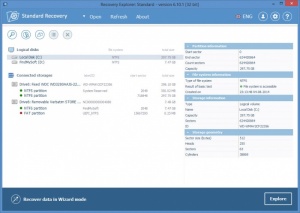
Recovery Explorer
Standard 6.10.1
Size: 13.7 MB
Downloads: 3033
Platform: Windows (All Versions)
Your best protection against data loss accidents are backups. If you have important data that you do not want to lose, then you’d best back it up! Having failed to do that, then you’re best alternative is to use a data recovery tool such as Recovery Explorer. I’ll be the first to admit that Recovery Explorer is a pro-grade tool that has extensive data recovery capabilities to offer. Still, data recovery is always I risky business and even with Recovery Explorer by your side, you might not always be able to recover your lost data.
The bottom line is this: Recovery Explorer is a powerful data recovery tool that will most likely bring back any data that you lost. Despite this fact, your best protection against data loss accidents are backups. Only a backup will ensure that you recover everything that you lost. Data recovery software could recover everything, but that’s not always a guarantee.
Recovery Explorer is available for Windows (XP SP3 or newer), Mac (Mountain Lion or newer), and Linux (any modern distro). Recovery Explorer is available as a Standard, Raid, and Professional Edition. The official Recovery Explorer website does a very good job of presenting the key differences between these editions.
Recovery Explorer Standard doesn’t provide support for RAID, but it does provide support for a wide range of other data storage devices: internal or external hard drives, USB drives, memory cards, disk images, and virtual disks. Furthermore, Recovery Explorer Standard provides support for a long list of file systems: Windows FAT, FAT32, ExFAT, NTFS; Mac HFS+; Linux EXT2, EXT3, EXT4, UFS, XFS, Reiser, JFS; and more. So no matter what sort of device you want to recover data from, Recovery Explorer Standard is sure to support it – as long as it’s not RAID.
If you’re an advanced user, you’re going to feel comfortable using the interface to find and recover lost data. If you’re not that experienced or perhaps you’re a novice, then you might want to give the Wizard a try. Thanks to this Wizard, recovering data becomes a very simple 3-step process:
Step 1 – select the drive or device that will be scanned.
Step 2 – initiate the scan and wait for it to complete (this may take a while).
Step 3 – go over the list of results and select the data you want to recover.
Please note that Recovery Explorer isn’t freeware. The trial will let you recover lost data, as long as the file size doesn’t go over 256KB. If you want to recover files that are larger than that, then you’re going to need to buy a license. At the time of writing this, a Home/Personal license for Recovery Explorer Standard is close to €40.
If you lost some files and you don’t have a backup, then Recovery Explorer will help you bring them back. This is a powerful, pro-grade data recovery tool that can handle any type of storage device and file system.
Pros
Recovery Explorer is available for Windows, Mac and Linux. Recovery Explorer is available as a Standard, RAID, and Professional Edition. Choose between the user friendly interface or the even friendlier Wizard Mode. You can recover data from pretty much any storage device you can think of (except RAID if you’re using the Standard Edition). You can preview files before recovering them.
Cons
Trial limitations: you can’t recover files larger than 256KB.
Recovery Explorer
Standard 6.10.1
Download
Recovery Explorer Awards

Recovery Explorer Editor’s Review Rating
Recovery Explorer has been reviewed by George Norman on 30 May 2017. Based on the user interface, features and complexity, Findmysoft has rated Recovery Explorer 5 out of 5 stars, naming it Essential
























